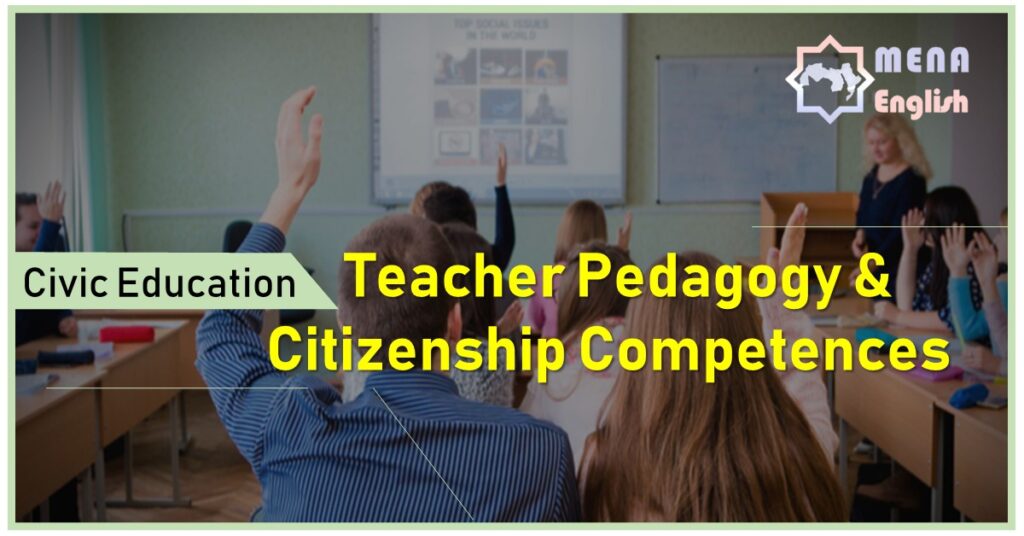
By Mourad EL HANAFI
One of the reasons researchers have initiated research in civics and citizenship is that civic disengagement is widespread across countries, especially among the youth. Civic disengagement can be seen through civic, political, and electoral indicators. That is, youth have shown palpable disengagement as regards community participation, volunteering, media use, and voting, to name but a few. As a reaction, modern democracies seek to change the status quo and build citizens that are of more benefit to their communities. More importantly, they want active, informed citizens. To this end, education systems are brought into play to shape citizens that would contribute to the quality of life in their communities and work for the common good while they are informed about their acts.
The present essay looks at ways to address civic disengagement through the education system. It further discusses relevant citizenship competences students should acquire to be active, informed citizens, and relevant pedagogies teachers are advised to employ in this regard.
In setting out to discuss citizenship competences and pedagogies, Print (2010) suggests that active, informed citizenship should clearly be defined. Hoskins (2006) asserts that active, informed citizenship entails “participation in civil society, community and/or political life, characterized by mutual respect and non-violence and in accordance with human rights and democracy” (p. 6). While being active takes different forms of engagement in society or community, the “informed” dimension of citizenship entails being aware of one’s rights and duties towards different segments of the society in the light of democracy. According to Hoskin’s (2006) definition above, being active is not restricted to political activity as traditional approaches emphasize; rather, it is exhaustive that it even includes less conventional forms such as cyber participation and single-issue politics. The definition is also ethically-driven in the fact that the “active” side of citizenship sees maintaining mutual respect and concord as a priority.
Democracies’ pursuit of good citizens is not yet clearly conceptualized by “active, informed citizenship”. The latter notion still needs to be more elaborate. In this regard, Westheimer and Kahne (2004) identify three versions of good citizens: (1) personally responsible citizen, (2) participatory citizen, and (3) social justice-oriented citizen. While all three aforementioned types of citizens are active and informed, they are also significantly different in a way. As the name suggests, personally responsible citizen does what is supposed of them as an individual; they obey the law, gives blood, picks up litter, stays out of debt, etc. On the other hand, participatory citizen is more helpful in the sense that they are proactive as they initiate change, whereas social justice-oriented citizen is the most desirable type of all for the simple reason that they are well-informed. Social justice-oriented citizen improves society by analysing and addressing social issues and injustices. However, in “democracies” that use citizenship as a tool to make more yes people or conformists, this type of citizen may not be favoured.
It is true that there are good citizens in communities, but we can never be certain if the qualities they have are traits or competences. Herein, formal curriculum plays a pivotal role because a trait is not as solid as a competence, which entails being well-informed. However, the question of what knowledge to teach in a bid to boost citizenship competences among students is problematic. Still, competences can partly be identified through analysing a group of ‘active’ behaviours such as political activities (voting, joining political parties, etc), community service (volunteering, working with welfare agencies, fundraising, etc), social mobilization (demonstrations, signing petitions, etc), and self-directing acts (problem-solving, saving water and energy, etc). These activities can also give hints to single out pedagogies that would be relevant in any particular context.
Research shows that civics subjects in school are linked with measures of civic engagement such as voting, volunteering and joining civic associations (Niemi & Junn, 1998; Saha & Print, 2010). Moreover, a substantial body of literature from the US shows that civics pedagogies associated with civic education usually include project-based learning, community service learning, simulations and workshops, and examining contemporary social problems and conflicts or controversial issues. The latter pedagogy has been shown to be effective but is often relegated to the sidelines as teachers do not risk creating discord in the classroom, and their knowledge of social and political issues is sometimes limited.
Countless are the pedagogies instructors can resort to in teaching citizenship competences. However, effective pedagogies are sometimes ignored. Interesting research findings show that participatory pedagogy in schools is quite weak (Print 2010). That is, instruction is still characterized by excessive use of textbooks and rote learning. Substantial research has also shown that participatory pedagogy is likely to engage students in experiential learning through activities like class voting, group inquiry, simulations, fieldwork and cooperative learning, which, by extension, improve communication skills. Moreover, open, informed, meaningful discussion with non-partisan teachers is highly significant in engaging students. Likewise, Verba et al (1995) conducted a retrospective study of adults and found out that high school students’ participation in informal curriculum activities, especially student government, was the most important school variable in predicting adult political activity.
Print (2010) further suggests a typology of pedagogical strategies in citizenship education. It includes three approaches along with the typical activities that go under each approach. In teacher-dominated approaches, all the activities are likely to be manipulated by the teachers with less engagement of the students. As regards the teacher-influenced approaches, the students are engaged, but experiential learning is not catered for. On the other hand, engaged-learner approaches are significantly effective. The students are in charge of their own learning under the teacher’s supervision and encouragement.
The essay looked at some key points that revolve around citizenship pedagogies and competences. Teachers have a wide range of pedagogies to employ in their instructional settings, but there is little research evidence to indicate which ones are most relevant and useful for building active, informed citizens. It is worth noting that the context affects the choice of pedagogies to employ. The essay also identified the types and characteristics of active, informed citizenship. Defining active, informed citizenship clearly helps democracies decide what knowledge to teach through the curriculum and have clues about what to expect from their citizens.
References:
Hoskins, B. (2006). Active citizenship for democracy. Ispra: CRELL.
Niemi, R., & Junn, J. (1998). Civic education: What makes students learn. New Haven, CT: Yale University Press.
Print, M. (2010). Citizenship education: Pedagogy that engages. Invited keynote address, Hiroshima, Japan: Hiroshima University.
Saha, L., & Print, M. (2010). Student school elections and political engagement: A cradle of democracy? International Journal of Educational Research, 49(1), 22–32.
Verba, S., Scholzman, K., & Brady, H. (1995). Voice and equality: Civic voluntarism in American politics. Cambridge, MA: Harvard University Press.
Westheimer, J., & Kahne, J. (2004). What kind of citizen? The politics of educating for democracy.American Educational Research Journal, 4(2), 237–269.
